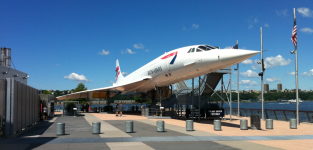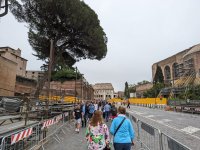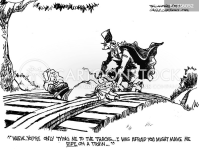Most of AC planes get stored in Arizona, the climate is friendly to the electronics
You are using an out of date browser. It may not display this or other websites correctly.
You should upgrade or use an alternative browser.
You should upgrade or use an alternative browser.
High speed trains
- Thread starter Baggsy
- Start date
Most of AC planes get stored in Arizona, the climate is friendly to the electronics
Arizona is for layup of aircraft that may either go back into service, or be scavenged for parts after any plan of returning to service is no longer planned.
All of the Concords on the other hand went to various museums, and some are even stored outside - BOAD is in NYC, I set hands on it when I was there in 2011.

Priller
Well-known member
The inability for English-speaking countries to build cost-effective railways is well documented. For a variety of reasons, we collectively can't get it done, and seem to be uniquely terrible at delivering large projects for a reasonable cost generally.
There'a an interesting paper that delves into some of the whys here:
https://stateofcitiessummit.ca/file...-Comparative-Study_2024-12-05-144410_bjnj.pdf
The high-speed rail system in Italy is so effective that it essentially put their national airline (Alitalia) out of business, as there was literally zero reason to fly for most Italians. The trains are cheaper, faster (door-to-door), more comfortable, and offer a much more dignified travel experience.
I was recently comparing a trip from Turin to Naples, which is a fair haul. To get from downtown to downtown, flying was *at best* about 20 minutes quicker. But considering the much higher chance of delay, the added cost of transport to and from airports, and above all, the extremely unpleasant travel experience of airports and budget airlines, taking the train is a no-brainer.
There's no good reason why a high-speed train from Windsor to Quebec City isn't viable except for the unnecessarily insane cost to build it. There's plenty of traffic throughout that corridor, whether it's flying or driving, so the demand is there. Even now, taking the train from Toronto to Montreal is about as quick as driving. If you could halve that travel time, it would be that much more appealing. Sadly, between giving NIMBY's way too much say, and umpteen businesses who profit massively from cost escalation (or who profit from not having effective mass transit), there's a lot of entrenched systems in place to prevent it.
There'a an interesting paper that delves into some of the whys here:
https://stateofcitiessummit.ca/file...-Comparative-Study_2024-12-05-144410_bjnj.pdf
The high-speed rail system in Italy is so effective that it essentially put their national airline (Alitalia) out of business, as there was literally zero reason to fly for most Italians. The trains are cheaper, faster (door-to-door), more comfortable, and offer a much more dignified travel experience.
I was recently comparing a trip from Turin to Naples, which is a fair haul. To get from downtown to downtown, flying was *at best* about 20 minutes quicker. But considering the much higher chance of delay, the added cost of transport to and from airports, and above all, the extremely unpleasant travel experience of airports and budget airlines, taking the train is a no-brainer.
There's no good reason why a high-speed train from Windsor to Quebec City isn't viable except for the unnecessarily insane cost to build it. There's plenty of traffic throughout that corridor, whether it's flying or driving, so the demand is there. Even now, taking the train from Toronto to Montreal is about as quick as driving. If you could halve that travel time, it would be that much more appealing. Sadly, between giving NIMBY's way too much say, and umpteen businesses who profit massively from cost escalation (or who profit from not having effective mass transit), there's a lot of entrenched systems in place to prevent it.
Even just the land cost for high speed rail in Ontario is insane. Expropriating land at every crossing for grade separation is thousands of acres. Maybe $25K per acre in the middle of nowhere up to millions per acre through cities. That is billions (and possibly over $10B) just in land cost in Ontario. Add in the insane construction costs and the whole thing cements itself as an economic dumpster fire. Construction of each grade separated crossing is $25-100M. To be honest, the final number for quebec city to windsor would probably be closer to $1T than it will be to zero.The inability for English-speaking countries to build cost-effective railways is well documented. For a variety of reasons, we collectively can't get it done, and seem to be uniquely terrible at delivering large projects for a reasonable cost generally.
There'a an interesting paper that delves into some of the whys here:
https://stateofcitiessummit.ca/file...-Comparative-Study_2024-12-05-144410_bjnj.pdf
The high-speed rail system in Italy is so effective that it essentially put their national airline (Alitalia) out of business, as there was literally zero reason to fly for most Italians. The trains are cheaper, faster (door-to-door), more comfortable, and offer a much more dignified travel experience.
I was recently comparing a trip from Turin to Naples, which is a fair haul. To get from downtown to downtown, flying was *at best* about 20 minutes quicker. But considering the much higher chance of delay, the added cost of transport to and from airports, and above all, the extremely unpleasant travel experience of airports and budget airlines, taking the train is a no-brainer.
There's no good reason why a high-speed train from Windsor to Quebec City isn't viable except for the unnecessarily insane cost to build it. There's plenty of traffic throughout that corridor, whether it's flying or driving, so the demand is there. Even now, taking the train from Toronto to Montreal is about as quick as driving. If you could halve that travel time, it would be that much more appealing. Sadly, between giving NIMBY's way too much say, and umpteen businesses who profit massively from cost escalation (or who profit from not having effective mass transit), there's a lot of entrenched systems in place to prevent it.
One thing is jobs for life, that’s how long it would take to build this thingEven just the land cost for high speed rail in Ontario is insane. Expropriating land at every crossing for grade separation is thousands of acres. Maybe $25K per acre in the middle of nowhere up to millions per acre through cities. That is billions (and possibly over $10B) just in land cost in Ontario. Add in the insane construction costs and the whole thing cements itself as an economic dumpster fire. Construction of each grade separated crossing is $25-100M. To be honest, the final number for quebec city to windsor would probably be closer to $1T than it will be to zero.
Priller
Well-known member
Sure, but land cost (soft costs per that paper) is hardly unique to Canada. It's not like real estate in central Milan is cheap. They're just much better at a) telling the complainers to eff off, allowing for more cost effective routes and much cheaper tunneling options, and b) reusing/sharing existing corridors.Even just the land cost for high speed rail in Ontario is insane. Expropriating land at every crossing for grade separation is thousands of acres. Maybe $25K per acre in the middle of nowhere up to millions per acre through cities. That is billions (and possibly over $10B) just in land cost in Ontario. Add in the insane construction costs and the whole thing cements itself as an economic dumpster fire. Construction of each grade separated crossing is $25-100M. To be honest, the final number for quebec city to windsor would probably be closer to $1T than it will be to zero.
In the end, similar to not building urban mass transit because of the cost, saying, "it's too expensive to be viable so let's not bother," kicks a critical can down the road and only ends up in it being even more expensive later. Our urban expansion is such that adding mass transit is the only solution to keep things viable. Building more highways or adding more lanes solves nothing. Toronto traffic is already broken and ends up as a massive drain on our economy. It's never going to magically get easy to fix, so we need to find ways of addressing cost escalation now rather than simply avoiding building.
Per the above paper, we need to have a clearer scope before things go to tender, make costing more transparent (all contract item rates public), reduce over-reliance on allocating contingency money (and even punishing people for not spending it), reduce our belt and suspenders design theories back to more realistic global standards, not allow external parties to drive design choices, especially for temporary disturbances during construction (NIMBYism etc.), develop more in-house expertise rather than relying on external consultants, standardise designs across a project to take advantage of economies of scale, among many other items.
Believe me, if Italy and Turkey can do it, we can do it. In an ideal world, a project of this scale would be a great way to totally revamp how we complete work like this. In the real world, I suspect we'll spend a stack of cash on environmental studies, community engagement, and preliminary designs, and end up with either nothing, or a project so reduced in scope that it'll be largely pointless...
sburns
Well-known member
The flip side to this, I believe there is a subway in Rome or someplace in Italy still under construction or has been for 40 years. Every time they dig it turns into a archaeology site. But like you said they are trying to build it, not shrugging it off.Sure, but land cost (soft costs per that paper) is hardly unique to Canada. It's not like real estate in central Milan is cheap. They're just much better at a) telling the complainers to eff off, allowing for more cost effective routes and much cheaper tunneling options, and b) reusing/sharing existing corridors.
In the end, similar to not building urban mass transit because of the cost, saying, "it's too expensive to be viable so let's not bother," kicks a critical can down the road and only ends up in it being even more expensive later. Our urban expansion is such that adding mass transit is the only solution to keep things viable. Building more highways or adding more lanes solves nothing. Toronto traffic is already broken and ends up as a massive drain on our economy. It's never going to magically get easy to fix, so we need to find ways of addressing cost escalation now rather than simply avoiding building.
Per the above paper, we need to have a clearer scope before things go to tender, make costing more transparent (all contract item rates public), reduce over-reliance on allocating contingency money (and even punishing people for not spending it), reduce our belt and suspenders design theories back to more realistic global standards, not allow external parties to drive design choices, especially for temporary disturbances during construction (NIMBYism etc.), develop more in-house expertise rather than relying on external consultants, standardise designs across a project to take advantage of economies of scale, among many other items.
Believe me, if Italy and Turkey can do it, we can do it. In an ideal world, a project of this scale would be a great way to totally revamp how we complete work like this. In the real world, I suspect we'll spend a stack of cash on environmental studies, community engagement, and preliminary designs, and end up with either nothing, or a project so reduced in scope that it'll be largely pointless...
We don't have these problems, I think some of or a lot of it is just poor civil planning. Most of the infrastructure here is poorly designed and implemented. Why did they choose to build the 401 right next to train tracks. Why not have left more room for both, we have ton's of land, just zone it off. Makes no sense to me.
We have similar but different problems. There needs to be archaeological studies along the entire new ROW. Find what could be a burial ground and often that means moving the ROW and repeating the process (or paying millions to first nations for each find to allow them to be disturbed). The chance you find many sites in ~200 sq km of construction zone is astronomical. Add in the lizards/fish/birds in the ROW and it becomes almost impossible to build without throwing out the restrictions we have in place.We don't have these problems, I think some of or a lot of it is just poor civil planning. Most of the infrastructure here is poorly designed and implemented. Why did they choose to build the 401 right next to train tracks. Why not have left more room for both, we have ton's of land, just zone it off. Makes no sense to me.
Why did they choose to build the 401 right next to train tracks.
To be fair, what is now the 401 existed as a small two-lane road, running along what was highway 2 in the 40’s and 50’s, and also the railway lines which existed long before that.
All the towns and businesses were along highway 2 and those rail lines as was customary at the time, so it made the absolute most sense at the time to put the highway there.
Foresight isn’t 20/20 unfortunately, and here we are.
sburns
Well-known member
Well that is exactly the point, so leave hwy 2 alone, build the 401 a few kilometres away from that.To be fair, what is now the 401 existed as a small two-lane road, running along what was highway 2 in the 40’s and 50’s, and also the railway lines which existed long before that.
All the towns and businesses were along highway 2 and those rail lines as was customary at the time, so it made the absolute most sense at the time to put the highway there.
Foresight isn’t 20/20 unfortunately, and here we are.
This is what is great about the intersate in the US. Someone used there head down there and put it (well in most places) out of the way. So you can get to A and B without tangling up the rest of the roads.
Well that is exactly the point, so leave hwy 2 alone, build the 401 a few kilometres away from that.
This is what is great about the intersate in the US. Someone used there head down there and put it (well in most places) out of the way. So you can get to A and B without tangling up the rest of the roads.
Except back then that would have been the equivalent of building a major highway in the middle of nowhere, without any major roads connecting this new highway to where homes and businesses actually existed.
And the USA has a lot of interstates that go smack through the middle of major cities. Boston comes to mind, although they spent billions and buried it after the fact, but there’s endless others. In many cases in the years following they built bypasses, but the main interstate itself still runs directly through the cities.
Last edited:
Priller
Well-known member
Rome is unique. It's hard to find a city more densely packed with history, and it's nut just new finds that slow things down. Much of that line is being built immediately adjacent to the Colosseum and Forum, so there's the dual challenges of both protecting what's already there as well as maintaining access for the throngs of tourists.The flip side to this, I believe there is a subway in Rome or someplace in Italy still under construction or has been for 40 years. Every time they dig it turns into a archaeology site. But like you said they are trying to build it, not shrugging it off.
It is agonisingly slow, though. Here's a pic from March 2016:

And May 2023 from when we were there last:

The grandstands and railings are for the upcoming Festa della Repubblica and are temporary. If you take those out, the only difference is the batching silos are gone. Progress is being made, but it's hard to see from the street...
Via is losing $600M a year. A high speed rail line will lose at least an order of magnitude more.

 toronto.citynews.ca
toronto.citynews.ca

Via Rail CEO blames plummeting on-time performance on CN speed rules
MONTREAL — Via Rail says its on-time performance fell drastically in the first three months of the year — a drop the Crown corporation blames largely on speed rules from Canadian National Railway Co. Via is reporting that its trains, which run mostly on CN tracks, pulled into the station within...


















